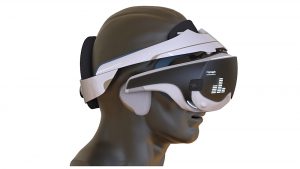Virtually Predictable

FIGURE: The nGoggle integrates electroencephalogram and eye tracking into VR goggles to objectively measure brain waves elicited by specific visual stimuli.
In early 2018, Duke launched its Visual Performance Laboratory (DVPL), a high-tech research lab created and led by Felipe Medeiros, MD, PhD, who joined Duke in August 2017 as the vice chair for technology and director of clinical research at the Duke Eye Center.
The DVPL uses virtual reality and other high-tech applications to investigate the ways in which eye disease impacts patients’ daily activities, to develop better methods of predicting which patients have a higher risk of functional impairments, and to create assistive technologies to improve the lives of those with impairment.
“From a patient’s standpoint, what really matters is whether their disease is going to affect their everyday lives: their ability to drive, read, or find things, or their risk of falling,” Medeiros notes. “If we can predict their individual risk levels, we’ll be able to make better decisions about how aggressively to treat them and how to help them optimize their quality of life as the disease progresses.”
In addition to finding new ways to assess functional performance and understand the mechanisms by which eye diseases like glaucoma and macular degeneration cause these impairments, the DVPL is linking the new tests with basic imaging techniques and traditional visual function assessments, as well as subjective assessments via patient questionnaires. These comprehensive datasets will help them build predictive models and testing devices that can be used in clinical practice, or even in the patient’s home.
Applying Innovative Technologies
To work toward achieving the DVPL’s goals, Medeiros and colleagues have done the following:
- Devised and patented the nGoggle, a device that integrates electroencephalogram and eye tracking into virtual reality (VR) goggles to objectively measure brain waves elicited by visual stimuli presented on the VR goggles. Although the nGoggle is still in development, its portability, affordability, and ability to transmit data wirelessly offer potential for widespread use.
- Developed an innovative VR paradigm to assess the risk of loss of balance and falls in subjects with eye diseases. In this test, subjects use VR goggles while standing on a force platform that measures their movements in response to visual stimuli designed to perturb their balance. The postural responses under this environment have been shown to be predictive of fall risk.
- Applied driving simulation to investigate fitness to drive and to develop innovative metrics for predicting driving risk in subjects with eye diseases. Based on these studies, they have crafted simple, tablet-based tests that assess visual function parameters most relevant to driving performance.
- Built new testing algorithms for diagnosing and monitoring eye diseases using innovative statistical and artificial intelligence frameworks. One of Medeiros’ algorithms, which combines data from conventional visual field testing with imaging from optical coherence tomography, has been shown to improve diagnosis, staging, and detection of progression in glaucoma compared with conventional metrics. The algorithm is being incorporated into commercially available devices.
As Duke Ophthalmology’s vice chair for technology, Medeiros says he is excited to bring opportunities to Duke, like a new partnership with Google Brain to devise methods for diagnosing glaucoma that could be spread worldwide, especially to underserved communities. Medeiros also envisions using artificial intelligence to sift through Duke’s extensive electronic medical records database to develop systems that can recommend treatment options for a current patient based on outcomes from previous patients under similar circumstances.